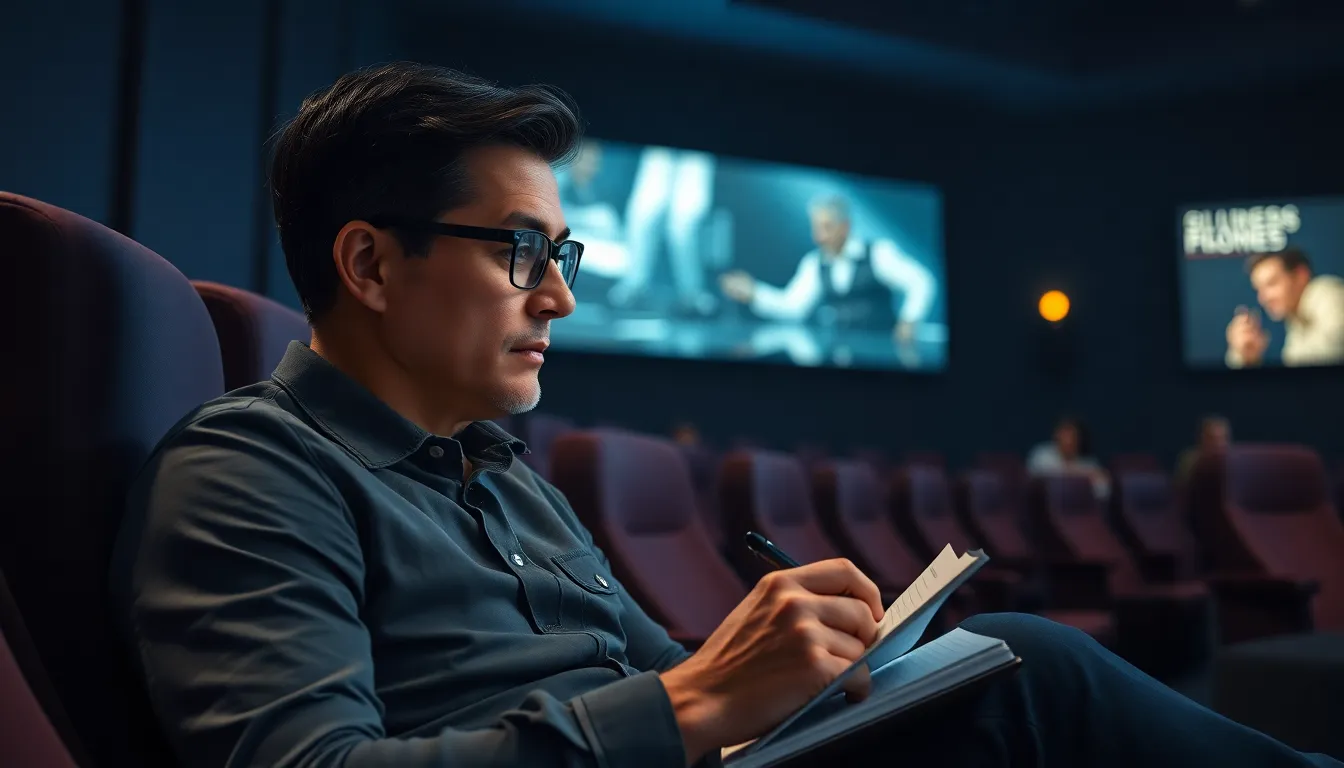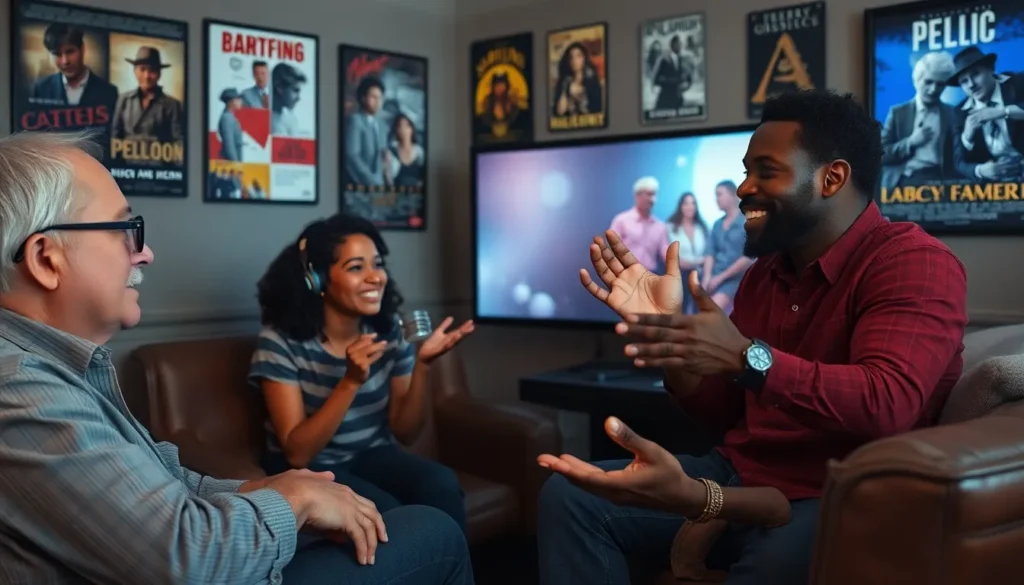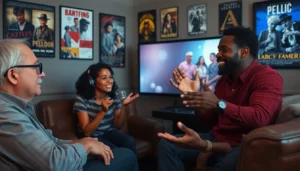Film critique isn’t just about watching movies; it’s an art form that shapes how audiences perceive cinema. From dissecting character development to analyzing cinematography, a well-crafted critique can enhance viewers’ understanding and appreciation of a film. Critics play a vital role in guiding audiences through the vast landscape of storytelling on screen.
In a world flooded with content, discerning what to watch can be overwhelming. A thoughtful critique provides clarity, offering insights that elevate the viewing experience. Whether it’s a blockbuster or an indie gem, understanding the nuances of film critique empowers viewers to engage more deeply with the narratives that unfold before them.
Understanding Film Critique
Film critique serves as an essential art form that shapes audience perceptions of cinema. It offers insights that enhance the appreciation of films while guiding viewer choices.
Definition and Importance
Film critique refers to the analysis and evaluation of films based on various aspects, including narrative structure, themes, performances, and technical elements. Critiques foster deeper connections between viewers and films by unpacking intricate details and interpretations. A well-crafted critique promotes critical thinking, encouraging audiences to reflect on their viewing experiences. Moreover, it supports filmmakers by providing constructive feedback that can lead to improved quality in future projects.
Historical Context
Film critique has evolved alongside cinema since its inception in the late 19th century. Early critiques primarily focused on technical aspects, such as editing and camera techniques. As cinematic storytelling developed, critics began to explore narrative devices and thematic elements, driving deeper conversations about film as an art form. By the mid-20th century, influential critics like Andrew Sarris and Pauline Kael emerged, establishing the concept of auteur theory and emphasizing the importance of an artist’s unique vision. This historical evolution highlights film critique’s critical role in shaping both cinema and audience engagement today.
Key Elements of Film Critique

Film critique encompasses several crucial elements that contribute to thorough analysis. Each element plays a significant role in how viewers perceive and engage with films.
Visual Storytelling
Visual storytelling involves the use of cinematography, editing, and composition to convey the narrative. Shots, framing, and lighting choices impact the audience’s emotional response. A well-crafted visual style enhances storytelling by immersing viewers in the film’s world. Critics assess how visuals support or detract from the narrative, noting the effectiveness of special effects, camera movements, and color palettes in evoking specific moods.
Character Development
Character development focuses on how characters evolve throughout the film. It examines depth, complexity, and relatability. Critics evaluate the motivations and arcs of protagonists and antagonists, assessing their impact on the narrative. Strong character development fosters emotional investment, while weak characterization can lead to disengagement. Analysts often highlight performances by actors, considering how effectively they bring characters to life and contribute to the overall story.
Themes and Messages
Themes and messages explore the underlying ideas presented in the film. A critique analyzes how well a film communicates its core themes, such as love, loss, or social justice. Critics investigate whether these messages resonate with the audience and if they provoke thought or discussion. Subtext, symbolism, and motifs enrich a film’s thematic depth, and critiques often assess how successfully filmmakers weave these elements into the narrative.
Approaches to Film Critique
Film critique employs various approaches that each offer distinct insights into cinema. Two prominent methodologies include formal analysis and personal interpretation, each contributing uniquely to the understanding of films.
Formal Analysis
Formal analysis focuses on a film’s technical components. This method assesses cinematography, editing, sound, and mise-en-scène to understand how these elements function together to create meaning. Critics examine shot composition, lighting techniques, and color palettes, linking them to narrative themes. For instance, a film that uses high contrast lighting may evoke tension, while vibrant colors might enhance emotional impact. By dissecting these formal elements, critics reveal how filmmakers communicate messages and evoke responses, fostering deeper audience engagement.
Personal Interpretation
Personal interpretation emphasizes subjective experiences and opinions of a film. Critics analyze characters’ motivations, themes, and overall emotional resonance, providing a unique lens through which to view a work. This approach values individual perspectives, allowing viewers to connect their own experiences with the narrative. For example, a critic may resonate with a character’s struggle, offering insights into how it reflects broader societal issues. Such interpretations enrich the critique process, encouraging diverse responses and discussions among audiences, and highlighting the power of personal engagement with film.
The Role of a Film Critic
Film critics play a crucial role in the cinematic landscape, shaping audience perception and contributing to meaningful dialogue about films. They evaluate various aspects of filmmaking, providing insights that enhance viewer experience.
Responsibilities and Challenges
Critics analyze films on multiple levels, ensuring a comprehensive understanding of narrative, technical elements, and thematic content.
- Assessing narratives involves examining plot structure, pacing, and coherence, offering audiences insights into the storytelling process.
- Evaluating performances considers actors’ portrayals, character depth, and emotional authenticity to determine their effectiveness in conveying the film’s message.
- Analyzing technical aspects includes scrutinizing cinematography, editing, sound design, and mise-en-scène to reveal how these elements contribute to the overall impact.
- Providing contextual analysis places films within cultural or historical frameworks, allowing audiences to appreciate the broader implications of the work.
Critics face challenges, such as avoiding personal biases and navigating differing audience expectations. They must balance subjective interpretation with objective analysis to deliver informed critiques.
Impact on Filmmaking
Film critics significantly influence the filmmaking process and industry standards.
- Shaping creative direction can occur through critiques that highlight strengths and weaknesses in narrative and execution, guiding filmmakers in future projects.
- Encouraging innovation arises when critics champion unique storytelling or experimental techniques, inspiring filmmakers to explore new boundaries.
- Establishing standards through consistent critique reinforces quality benchmarks, encouraging both mainstream and independent filmmakers to elevate their craft.
- Fostering audience engagement enables critics to bridge the gap between films and viewers, cultivating a more informed and reflective audience, which in turn influences how filmmakers approach their work.
Such contributions underscore the vital role of film critics in not just interpreting cinema, but also in nurturing the art form itself.
Film critique serves as a bridge between audiences and the cinematic world. It enriches viewers’ experiences by providing insights that deepen their appreciation for storytelling and artistry. By evaluating films through various lenses critics foster a culture of critical thinking and dialogue that benefits both filmmakers and audiences alike.
As the landscape of cinema continues to evolve film critique remains essential. It not only highlights the nuances of filmmaking but also encourages viewers to engage with films on a more profound level. In an era where choices abound critics play a pivotal role in guiding audiences toward meaningful cinematic experiences. Ultimately film critique is more than just analysis; it’s a vital conversation that shapes the future of cinema.





